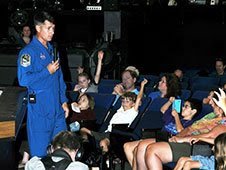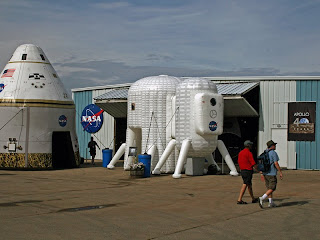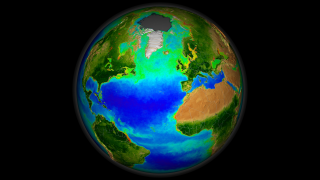Robert Shane Kimbrough Visits the Atlanta Braves


 NASA astronaut Robert Shane Kimbrough had two dreams growing up as a child; to be an astronaut and to play baseball. He grew up in the small town of Smyrna, Ga., just outside of Atlanta. Recently Kimbrough’s two passions came together while making a special appearance in his native Georgia. He spoke to the people of Atlanta about being an astronaut and was given the opportunity to participate in pregame activities for an Atlanta Braves’ game.
NASA astronaut Robert Shane Kimbrough had two dreams growing up as a child; to be an astronaut and to play baseball. He grew up in the small town of Smyrna, Ga., just outside of Atlanta. Recently Kimbrough’s two passions came together while making a special appearance in his native Georgia. He spoke to the people of Atlanta about being an astronaut and was given the opportunity to participate in pregame activities for an Atlanta Braves’ game.Kimbrough’s appearance in Atlanta marked the second stop of NASA’s Hometown Hero 2009 campaign. He is one of several astronauts returning to their home regions to spread knowledge about the importance of continuing space exploration. At each stop, the astronauts participate in pregame activities at a Major League Baseball game and do community outreach about NASA, the International Space Station, and why space exploration is so vital to the nation.
Kimbrough started his trip with an event-filled afternoon at the Fernbank Science Center. Sporting his blue flight suit, he did media interviews and presented his post-flight presentation to a group of aviation camp kids and the public. Kimbrough talked about the importance of education and raising the next generation’s interest in science and space exploration. The evening wrapped up with a free planetarium show for all who attended.
“It was a pleasure to host Lt. Col. Kimbrough at the Fernbank Science Center,” said Fernbank Science Center Director Doug Hrabe. “The groups were very appreciative of the time that he shared with them.”
The trip continued early next morning with three live interviews. Kimbrough stopped by WXIA-TV to talk with Karyn Greer about his recent mission, STS-126, and his time onboard the space station, where he performed two space walks. Kimbrough also had a radio interview with Kevin and Taylor in the Morning from 104.7 “The Fish.” He discussed the 10-year anniversary of the space station and how there are significant benefits derived from research conducted in space.
“All the things we do up there are to help people on Earth,” Kimbrough said. “We don’t do it for our sake or NASA’s sake—it’s to go up there and figure out how to live better on Earth.”
His last stop of the morning was at WAGA-TV. Kimbrough visited with Suchita Vadlamani. He recounted his days of growing up in Georgia and why he really became an astronaut.
“What first sparked your imagination and inspired you to be an astronaut?” Vadlamani asked.
“People my age were watching men walk on the moon, and that’s really what sparked the whole thing,” Kimbrough said.
After the early morning interviews, Kimbrough headed to Georgia Tech, where he made a post-flight presentation and signed autographs for students and summer campers. Kimbrough received a Master of Science degree in operations research from the Georgia Institute of Technology in 1998, so his visit was somewhat of a welcome home party.
Kimbrough ended his two-day trip with a major strike! He participated in numerous pregame activities at the Atlanta Braves versus Boston Red Sox game. He presented the general manager with a special photo taken from the space station. Later, Kimbrough and his son Zack also gave the “Play ball” call to start the game. But his journey didn’t end there. He signed several autographs and gave a live interview in the Braves’ plaza.
In the end, Kimbrough enjoyed his Hometown Heroes trip and thought the diversity of his events helped educate people about NASA and its goals.
“I had a chance to speak to kids, college students, the public and athletes, which is a very broad spectrum of folks,” Kimbrough said. “I think we did a lot of good for NASA overall.”
For more information about the NASA Hometown Heroes 2009 campaign, visit: http://www.nasa.gov/astronauts



 2:26 AM
2:26 AM
 sheldon
,
sheldon
,




































